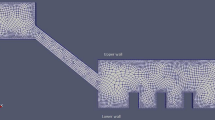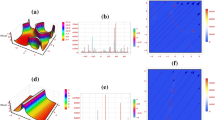Abstract
We examine the implementation of a wave-breaking mechanism into a nonlinear potential flow solver. The success of the mechanism will be studied by implementing it into the numerical model HOS-NWT, which is a computationally efficient, open source code that solves for the free surface in a numerical wave tank using the high-order spectral (HOS) method. Once the breaking mechanism is validated, it can be implemented into other nonlinear potential flow models. To solve for wave-breaking, first a wave-breaking onset parameter is identified, and then a method for computing wave-breaking associated energy loss is determined. Wave-breaking onset is calculated using a breaking criteria introduced by Barthelemy et al. (J Fluid Mech https://arxiv.org/pdf/1508.06002.pdf, submitted) and validated with the experiments of Saket et al. (J Fluid Mech 811:642–658, 2017). Wave-breaking energy dissipation is calculated by adding a viscous diffusion term computed using an eddy viscosity parameter introduced by Tian et al. (Phys Fluids 20(6): 066,604, 2008, Phys Fluids 24(3), 2012), which is estimated based on the pre-breaking wave geometry. A set of two-dimensional experiments is conducted to validate the implemented wave breaking mechanism at a large scale. Breaking waves are generated by using traditional methods of evolution of focused waves and modulational instability, as well as irregular breaking waves with a range of primary frequencies, providing a wide range of breaking conditions to validate the solver. Furthermore, adjustments are made to the method of application and coefficient of the viscous diffusion term with negligible difference, supporting the robustness of the eddy viscosity parameter. The model is able to accurately predict surface elevation and corresponding frequency/amplitude spectrum, as well as energy dissipation when compared with the experimental measurements. This suggests the model is capable of calculating wave-breaking onset and energy dissipation successfully for a wide range of breaking conditions. The model is also able to successfully calculate the transfer of energy between frequencies due to wave focusing and wave breaking. This study is limited to unidirectional waves but provides a valuable basis for future application of the wave-breaking model to a multidirectional wave field. By including parameters for removing energy due to wave-breaking into a nonlinear potential flow solver, the risk of developing numerical instabilities due to an overturning wave is decreased, thereby increasing the application range of the model, including calculating more extreme sea states. A computationally efficient and accurate model for the generation of a nonlinear random wave field is useful for predicting the dynamic response of offshore vessels and marine renewable energy devices, predicting loads on marine structures, and in the study of open ocean wave generation and propagation in a realistic environment.
























Similar content being viewed by others
References
Babanin A (2011) Breaking and dissipation of ocean surface waves. Cambridge University Press, Cambridge
Babanin AV, Chalikov D, Young IR, Savelyev I (2010) Numerical and laboratory investigation of breaking of steep two-dimensional waves in deep water. J Fluid Mech 644:433. https://doi.org/10.1017/S002211200999245X
Barthelemy X, Banner ML, Peirson WL, Fedele F, Allis M, Dias F (submitted) On a unified breaking onset threshold for gravity waves in deep and intermediate depth water. J Fluid Mech https://arxiv.org/pdf/1508.06002.pdf
Bihs H, Kamath A, Chella MA, Aggarwal A, Arntsen ØA (2016) A new level set numerical wave tank with improved density interpolation for complex wave hydrodynamics. Comput Fluids 140:191–208
Chalikov D, Sheinin D (2005) Modeling extreme waves based on equations of potential flow with a free surface. J Comput Phys 210:247–273. https://doi.org/10.1016/j.jcp.2005.04.008
Chen G, Kharif C, Zaleski S, Li J (1999) Two-dimensional navier–stokes simulation of breaking waves. Phys Fluids 11(1):121–133
Chen Q, Kirby JT, Dalrymple RA, Kennedy AB, Chawla A (2000) Boussinesq modeling of wave transformation, breaking, and runup. ii: 2d. J Waterw Port Coastal Ocean Eng 126(1):48–56
Deike L, Melville WK, Popinet S (2016) Air entrainment and bubble statistics in breaking waves. J Fluid Mech 801:91–129
Derakhti M, Kirby J (2016) Breaking-onset, energy and momentum flux in unsteady focused wave packets. J Fluid Mech 790:553–581. https://doi.org/10.1017/jfm.2016.17
Derakhti M, Kirby JT (2014) Bubble entrainment and liquid–bubble interaction under unsteady breaking waves. J Fluid Mech 761:464–506
Derakhti M, Kirby JT, Shi F, Ma G (2016a) Wave breaking in the surf zone and deep-water in a non-hydrostatic RANS model. part 1: Organized wave motions. Ocean Modelling 107:125–138 https://doi.org/10.1016/j.ocemod.2016.09.001
Derakhti M, Kirby JT, Shi F, Ma G (2016b) Wave breaking in the surf zone and deep-water in a non-hydrostatic RANS model. part 2: Turbulence and mean circulation. Ocean Modelling 107:139–150 https://doi.org/10.1016/j.ocemod.2016.09.011
Dias F, Dyachenko AI, Zakharov VE (2008) Theory of weakly damped free-surface flows: A new formulation based on potential flow solutions. Phys Lett Sect A: Gen Atom Solid State Phys 372(8):1297–1302. https://doi.org/10.1016/j.physleta.2007.09.027
Dommermuth DG, Yue DK (1987) A high-order spectral method for the study of nonlinear gravity waves. J Fluid Mech 184:267–288
Ducrozet G, Bonnefoy F, Le Touzé D, Ferrant P (2007) 3-D HOS simulations of extreme waves in open seas. Nat Hazards Earth Syst Sci 7(1):109–122. https://doi.org/10.5194/nhess-7-109-2007
Ducrozet G, Bonnefoy F, Le Touzé D, Ferrant P (2012) A modified High-Order Spectral method for wavemaker modeling in a numerical wave tank. Eur J Mech B/Fluids 34:19–34. https://doi.org/10.1016/j.euromechflu.2012.01.017
Ducrozet G, Bonnefoy F, Ferrant P (2016a) On the equivalence of unidirectional rogue waves detected in periodic simulations and reproduced in numerical wave tanks. Ocean Eng 117:346–358
Ducrozet G, Bonnefoy F, Le Touzé D, Ferrant P (2016b) HOS-ocean: Open-source solver for nonlinear waves in open ocean based on high-order spectral method. Computer Physics Communications 203:245–254. https://doi.org/10.1016/j.cpc.2016.02.017
Fedele F (2014) Geometric phases of water waves. EPL (Europhysics Letters) 107:69001
Fedele F, Chandre C, Farazmand M (2016) Kinematics of fluid particles on the sea surface: Hamiltonian theory. J Fluid Mech 801:260–288
Fernandez-Mora A, Ribberink JS, van der Zanden J, van der Werf JJ, Jacobsen NG (2017) Rans-vof modeling of hydrodynamics and sand transport under full-scale non-breaking and breaking waves. Coast Eng Proc 1(35):29
Gouin M, Ducrozet G, Ferrant P (2016) Development and validation of a non-linear spectral model for water waves over variable depth. Eur J Mech-B/Fluids 57:115–128
Gouin M, Ducrozet G, Ferrant P (2017) Propagation of 3d nonlinear waves over an elliptical mound with a high-order spectral method. Eur J Mech-B/Fluids 63:9–24
Goullet A, Choi W (2011) Nonlinear evolution of irregular surface waves: Comparison of numerical solutions with laboratory experiments for long crested waves. Phys Fluids 23:016601
Iafrati A (2009) Numerical study of the effects of the breaking intensity on wave breaking flows. J Fluid Mech 622:371–411. https://doi.org/10.1017/S0022112008005302
Iafrati A, Babanin A, Onorato M (2014) Modeling of ocean – atmosphere interaction phenomena during the breaking of modulated wave trains. J Comput Phys 271:151—-171
Kennedy AB, Chen Q, Kirby JT, Dalrymple RA (2000) Boussinesq modeling of wave transformation, breaking, and runup. i: 1d. J Waterw Port Coast Ocean Eng 126(1):39–47
Kurnia R, van Groesen E (2014) High order Hamiltonian water wave models with wave-breaking mechanism. Coast Eng 93:55–70. https://doi.org/10.1016/j.coastaleng.2014.08.002
Lim HJ (2010) Experimental study on kinematics and dynamics of breaking waves in deep water. PhD thesis, Texas A&M University, TX
Longuet-Higgins MS (1992) Theory of weakly damped stokes waves: a new formulation and its physical interpretation. J Fluid Mech 235:319–324
Ma G, Shi F, Kirby JT (2012) Shock-capturing non-hydrostatic model for fully dispersive surface wave processes. Ocean Model 43-44:22–35. https://doi.org/10.1016/j.ocemod.2011.12.002
Na B, Chang KA, Huang ZC, Lim HJ (2016) Turbulent flow field and air entrainment in laboratory plunging breaking waves. J Geophys Res Oceans 121(5):2980–3009
Pizzo N, Deike L, Melville WK (2016) Current generation by deep-water breaking waves. J Fluid Mech 803:275–291
Rapp RJ, Melville W (1990) Laboratory measurements of deep-water breaking waves. Philos Trans Royal Soc Lond A: Math Phys Eng Sci 331(1622):735–800
Ruvinsky K, Feldstein F, Freidman G (1991) Numerical simulations of the quasi-stationary stage of ripple excitation by steep gravity–capillary waves. J Fluid Mech 230:339–353
Saket A, Peirson W, Banner M, Barthelemy X, Allis M (2017) On the threshold for wave breaking of two-dimensional deep water wave groups in the absence and presence of wind. J Fluid Mech 811:642–658. https://doi.org/10.1017/jfm.2016.776
Seiffert BR, Ducrozet G, Bonnefoy F (2017) Simulation of breaking waves using the high-order spectral method with laboratory experiments: Wave-breaking onset. Ocean Model 119:94–104
Shuxiu L, Zhaochena S, Yihui Z, Jiafa S, Yifei Z (2015) Laboratory Study on the Characteristics of Deep-water Breaking Waves. Procedia Eng 116:414–421. https://doi.org/10.1016/j.proeng.2015.08.304, http://linkinghub.elsevier.com/retrieve/pii/S1877705815019591
Sriram V, Schlurmann T, Schimmels S (2015) Focused wave evolution using linear and second order wavemaker theory. Appl Ocean Res 53:279–296. https://doi.org/10.1016/j.apor.2015.09.007
Tian Z, Perlin M, Choi W (2008) Evaluation of a deep-water wave breaking criterion. Phys Fluids 20 (6):066604. https://doi.org/10.1063/1.2939396
Tian Z, Perlin M, Choi W (2010) Energy dissipation in two-dimensional unsteady plunging breakers and an eddy viscosity model. J Fluid Mech 655:217–257. https://doi.org/10.1017/S0022112010000832
Tian Z, Perlin M, Choi W (2011) Frequency spectra evolution of two-dimensional focusing wave groups in finite depth water. J Fluid Mech 688:169–194. https://doi.org/10.1017/Jfm.2011.371
Tian Z, Perlin M, Choi W (2012) An eddy viscosity model for two- dimensional breaking waves and its validation with laboratory experiments. Phys Fluids 24(3):036601. https://doi.org/10.1063/1.3687508
Tulin MP, Waseda T (1999) Laboratory observations of wave group evolution, including breaking effects. J Fluid Mech 378:197–232. https://doi.org/10.1017/S0022112098003255
Wang Z, Yang J, Koo B, Stern F (2009) A coupled level set and volume-of-fluid method for sharp interface simulation of plunging breaking waves. Int J Multiphase Flow 35(3):227–246
West BJ, Brueckner KA, Janda RS, Milder DM, Milton RL (1987) A new numerical method for surface hydrodynamics. J Geophys Res 92(11):803–11
Wu CH, Nepf HM (2002) Breaking criteria and energy losses for three-dimensional wave breaking. J Geophys Res 107(C10):3177. https://doi.org/10.1029/2001JC001077
Acknowledgments
The assistance of Félicien Bonnefoy, of the LHEEA Lab at École Centrale de Nantes, received during the course of the experiments, is greatly appreciated. The authors are grateful for the experimental data provided by Dr. Zhigang (Kevin) Tian.
Author information
Authors and Affiliations
Corresponding author
Additional information
Responsible Editor: Bruno Castelle
Rights and permissions
About this article
Cite this article
Seiffert, B.R., Ducrozet, G. Simulation of breaking waves using the high-order spectral method with laboratory experiments: wave-breaking energy dissipation. Ocean Dynamics 68, 65–89 (2018). https://doi.org/10.1007/s10236-017-1119-3
Received:
Accepted:
Published:
Issue Date:
DOI: https://doi.org/10.1007/s10236-017-1119-3




